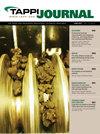亚临界水中木质素转化生物油的加速老化
IF 0.6
4区 农林科学
Q4 MATERIALS SCIENCE, PAPER & WOOD
引用次数: 4
摘要
研究了木质素生物油在不同老化温度(50℃和80℃)和时间(1小时、1天、1周和1个月)下的加速老化。以硫酸盐木质素为原料,以苯酚为封盖剂,碱(碳酸钾和氢氧化钾)和二氧化锆为催化体系,在亚临界水中进行水热液化制备生物油。测定了生物油的元素组成、分子量(通过凝胶渗透色谱法)和化学组成(通过气相色谱-质谱法和二维核磁共振[18.8 T, DMSO-d(6)]),以便更好地了解加速老化过程后发生的变化。与生物质热解生物油相比,木质素水热液化生物油具有较好的稳定性。80℃陈化1个月后,低分子量馏分(轻质油)的收率从64.1%下降到58.1%,四氢呋喃不溶馏分的收率从16.5%提高到22.2%。苯酚和酚醛二聚体(Ar-CH2-Ar)与其他芳香取代基(即甲氧基和醛基)相比具有较高的反应活性;这些物质可能参与水热液化生物油在加速老化过程中的聚合/缩合反应。此外,老化原油芳香族区高分子量组分(重油)的二维异核单量子相干核磁共振谱显示,该组分的结构为苯酚-烷基构型的组合,老化后Ar-2、Ar-5和Ar-6的愈创木酚交叉峰表明在老化过程中形成了新的聚合物。应用:纸浆厂人员在考虑从黑液中提取木质素并将其进一步加工成生物油的技术时,可以使用这些信息。本文章由计算机程序翻译,如有差异,请以英文原文为准。
Accelerated aging of bio-oil from lignin conversion in subcritical water
Accelerated aging of bio-oil derived from lignin was investigated at different aging temperatures (50 degrees C and 80 degrees C) and times (1 hour, 1 day, 1 week, and 1 month). The bio-oil used was produced by the hydrothermal liquefaction of kraft lignin, using phenol as the capping agent, and base (potassium carbonate and potassium hydroxide) and zirconium dioxide as the catalytic system in subcritical water. Elemental composition, molecular weight (by using gel permeation chromatography), and chemical composition (by using gas chromatography-mass spectrometry and 2D nuclear magnetic resonance [18.8 T, DMSO-d(6)]) of the bio-oil were measured to gain better understanding of the changes that occurred after being subjected to an accelerated aging process. The lignin-derived hydrothermal liquefaction bio-oil was quite stable compared with biomass-pyrolysis bio-oil. The yield of the low molecular weight fraction (light oil) decreased from 64.1% to 58.1% and that of tetrahydrofuran insoluble fraction increased from 16.5% to 22.2% after aging at 80 degrees C for 1 month. Phenol and phenolic dimers (Ar-CH2-Ar) had high reactivity compared with other aromatic substituents (i.e., methoxyl and aldehyde groups); these may participate in the polymerization/condensation reactions in the hydrothermal liquefaction bio-oil during accelerated aging. Moreover, the 2D heteronuclear single quantum coherence nuclear magnetic resonance spectra of the high molecular weight fraction (heavy oil) in the aged raw oil in the aromatic region showed that the structure of this fraction was a combination of phenol-alkyl patterns, and the guaiacol cross-peaks of Ar-2, Ar-5, and Ar-6 after aging indicate that a new polymer was formed during the aging process. Application: Pulp mill personnel can use this information when considering technology to extract lignin from black liquor and process it further into bio-oil.
求助全文
通过发布文献求助,成功后即可免费获取论文全文。
去求助
来源期刊

Tappi Journal
工程技术-材料科学:纸与木材
CiteScore
1.30
自引率
16.70%
发文量
59
审稿时长
6-12 weeks
期刊介绍:
An internationally recognized technical publication for over 60 years, TAPPI Journal (TJ) publishes the latest and most relevant research on the forest products and related industries. A stringent peer-review process and distinguished editorial board of academic and industry experts set TAPPI Journal apart as a reliable source for impactful basic and applied research and technical reviews.
Available at no charge to TAPPI members, each issue of TAPPI Journal features research in pulp, paper, packaging, tissue, nonwovens, converting, bioenergy, nanotechnology or other innovative cellulosic-based products and technologies. Publishing in TAPPI Journal delivers your research to a global audience of colleagues, peers and employers.
 求助内容:
求助内容: 应助结果提醒方式:
应助结果提醒方式:


